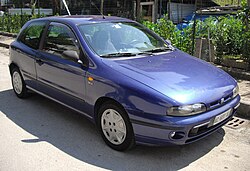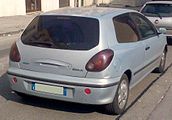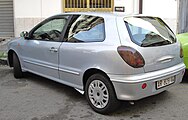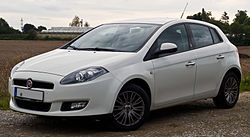Fiat Bravo
| Fiat Bravo | |
|---|---|
| Production period: | 1995-2001 2007-2014 |
| Class : | Compact class |
| Body versions : | Station wagon |
| Previous model: | Fiat Tipo |
| Successor: |
Fiat Stilo (2001-2007) Fiat Aegea (since 2015) |
Fiat Bravo is the name of two compact class passenger car models produced by the Italian car manufacturer Fiat .
The first model (type 182) was built from autumn 1995 to summer 2001 and replaced the Fiat Tipo . It was replaced by the Fiat Stilo , which was produced until the beginning of 2007. Its successor model was again called Bravo (Type 198). With this model name Fiat wanted to build on the sales success of the first Bravo after the Stilo had proven to be less than successful. Production was stopped in summer 2014.
Bravo (Type 182)
| 1st generation | |
|---|---|
|
Fiat Bravo (1995-1998) |
|
| Production period: | 1995-2001 |
| Body versions : | Station wagon |
| Engines: |
Otto engines : 1.2–2.0 liters (55–113 kW) Diesel engines : 1.9 liters (48–77 kW) |
| Length: | 4025 mm |
| Width: | 1755 mm |
| Height: | 1420 mm |
| Wheelbase : | 2540 mm |
| Empty weight : | 1010-1190 kg |
The first-generation Fiat Bravo was a three-door, while the five-door counterpart was sold under its own name, Fiat Brava . Fiat offered the notchback and station wagon versions from late summer 1996 to the end of 2002 as Marea . The design of the Bravo was developed in Fiat's Centro Stile under the direction of Ermanno Cressoni .
The Bravo was voted Car of the Year 1996. Motors from 48 to 113 kW were available to the buyer:
Engines
| model | Displacement | cylinder | power | construction time |
|---|---|---|---|---|
| Gasoline engine | ||||
| 1.2 16V | 1242 cc | 4th | 59 kW (80 PS) | 10 / 2000-10 / 2001 |
| 60 kW (82 PS) | 12 / 1998-10 / 2000 | |||
| 1.4 12V | 1370 cc | 4th | 55 kW (75 PS) | 10/1995-12/1997 |
| 59 kW (80 PS) | 12/1997–11/1998 | |||
| 1.6 16V | 1581 cc | 4th | 66 kW (90 PS) | 10 / 1995-07 / 1998 |
| 76 kW (103 PS) | 03 / 1996-10 / 2000 | |||
| 1596 cc | 10 / 2000-10 / 2001 | |||
| 1.8 16V | 1747 cc | 4th | 83 kW (113 hp) | 10 / 1995-10 / 2000 |
| 2.0 HGT 20V | 1998 cc | 5 | 108 kW (147 hp) | 10 / 1995-07 / 1998 |
| 113 kW (154 hp) | 07 / 1998-10 / 2000 | |||
| diesel | ||||
| 1.9 D * | 1910 cc | 4th | 48 kW (65 hp) | 10/1995-12/1997 |
| 1.9 TD 75 | 1910 cc | 4th | 55 kW (75 PS) | 03 / 1996-10 / 2000 |
| 1.9 TD 100 | 1910 cc | 4th | 74 kW (100 PS) | 03 / 1996-11 / 1998 |
| 1.9 JTD | 1910 cc | 4th | 74 kW (100 PS) | 10 / 2000-10 / 2001 |
| 1.9 JTD 105 | 1910 cc | 4th | 77 kW (105 PS) | 12 / 1998-10 / 2000 |
* not available on the German market.
The naturally aspirated diesel engine at the time was offered at a very early by engines of the first generation of turbo diesel replaced aggregates.
In autumn 1998, a newly developed common rail diesel engine was finally used in the compact car. At the same time, the 1.4-l engine, characterized as inelastic and thirsty, was taken out of the range and replaced by a new 1.2-l 16V engine. These changes in the engine range were carried out as part of a facelift, in which smaller optical details (such as painted bumper strips) and the equipment variants were revised. From then on, side airbags were also part of the standard equipment.
The Bravo was available in the equipment variants S (only 1.4 and 1.9D / TD), SX (1.2, 1.4, 1.6, 1.8, 1.9D / TD / JTD), GT (initially only 1.8 and 1.9 JTD, later also 1.6), as well as HGT (only 2.0).
According to ADAC information, the E10 fuel is not suitable for the "Benziner Bravo / Brava (model number 182): 1.6 16V" model.
- Special models
- Steel
- Trofeo
- suite
Bravo (type 198)
| 2nd generation | |
|---|---|
|
European model (2007-2014) |
|
| Production period: | 2007-2014 |
| Body versions : | Station wagon |
| Engines: |
Gasoline engines : 1.4 liters (66–110 kW) Diesel engines : 1.6–2.0 liters (77–121 kW) |
| Length: | 4336 mm |
| Width: | 1792 mm |
| Height: | 1498 mm |
| Wheelbase : | 2600 mm |
| Empty weight : | 1280-1435 kg |
| Stars in the Euro NCAP - Crash Test |
|
After the Fiat Stilo was phased out, the successor came again under the name Bravo on April 21, 2007 on the German market. This model was only offered as a five-door hatchback. The name Brava , which had been used in the first series for the five-door version, was omitted.
The special thing about this vehicle was the complete development in a virtual environment at Magna Steyr in Austria. All stages as well as the crash simulations were carried out on the computer. This enabled Fiat to reduce the number of prototypes required for development to five. No other manufacturer had previously chosen this route. Thus, new paths were broken during the development phase.
An acoustic version of the title Meravigliosa Creatura by the Italian singer Gianna Nannini was used for the international commercial . The success of the song and the commercial helped the album Perle to reach the top 50 sales charts.
Since 2008 the Fiat Bravo has also been available in Australia under the name Ritmo , which has already been used , to avoid confusion with the Mazda Bravo .
In July 2014, production of the Bravo in Europe ended. In Brazil, however, it is still produced.
Equipment variants
Petrol engines
| designation | Active | Dynamic | emotion | MyLife | Racing | speed | Sports | Sport Plus |
|---|---|---|---|---|---|---|---|---|
| 1.4 l (66 kW) |
|
|
|
|
|
|
|
|
| 1.4 l T-Jet (88 kW) |
|
|
|
|
|
|
|
|
| 1.4 l T-Jet (103 kW) |
|
|
|
|
|
|
|
|
| 1.4 l T-Jet (110 kW) |
|
|
|
|
|
|
|
|
Diesel engines
| designation | Active | Dynamic | emotion | MyLife | Racing | speed | Sports | Sport Plus |
|---|---|---|---|---|---|---|---|---|
| 1.6 l 16V Multijet (77 kW) |
|
|
|
|
|
|
|
|
| 1.6 l 16V Multijet (88 kW) |
|
|
|
|
|
|
|
|
| 1.9 l 16V Multijet (110 kW) |
|
|
|
|
|
|
|
|
| 1.9 l 8V Multijet (88 kW) (EU vehicles) |
|
|
|
|
|
|
|
|
| 2.0 l 16V Multijet (121 kW) |
|
|
|
|
|
|
|
|
With the 2012 model year, the program was reorganized. The most powerful diesel engine was dropped without replacement. In addition, the equipment lines were renamed. They are now called Pop (replaces Active, not available in Germany), Easy (replaces Dynamic), Lounge (replaces Emotion) and Sport. The discontinued special model MyLife has been replaced by the Street variant.
Engines
| model | Displacement | cylinder | power | Max. Torque | construction time |
|---|---|---|---|---|---|
| Gasoline engine | |||||
| 1.4 16V | 1368 cc | 4th | 66 kW (90 PS) at 5500 rpm | 128 Nm at 4500 rpm | 03/2007–03/2010 |
| 128 Nm at 3000 rpm | 03/2010–07/2014 | ||||
| 1.4 16V T-JET | 1368 cc | 4th | 88 kW (120 PS) at 5000 rpm | 206 Nm at 1750 rpm | 03 / 2007-07 / 2014 |
| 1.4 16V T-JET Multiair | 1368 cc | 4th | 103 kW (140 PS) at 5500 rpm | 230 Nm at 1750 rpm | 08/2010–07/2014 |
| 1.4 16V T-JET | 1368 cc | 4th | 110 kW (150 PS) at 5500 rpm | 206 Nm at 2250 rpm with overboost 230 Nm at 3000 rpm |
09/2007 - 05/2010 |
| diesel | |||||
| 1.6 16V Multijet 1 | 1598 cc | 4th | 66 kW (90 PS) at 4000 rpm | 290 Nm at 1500 rpm | 02 / 2009-07 / 2014 |
| 1.6 16V Multijet | 1598 cc | 4th | 77 kW (105 PS) at 4000 rpm | 290 Nm at 1500 rpm | 02/2008 - 02/2012 |
| 1.6 16V Multijet | 1598 cc | 4th | 88 kW (120 PS) at 4000 rpm | 300 Nm at 1500 rpm | 03/2008 - 07/2014 |
| 1.9 Multijet 8V | 1910 cc | 4th | 88 kW (120 PS) at 4000 rpm | 255 Nm at 2000 rpm | 03/2007-06/2008 |
| 1.9 Multijet 16V | 1910 cc | 4th | 110 kW (150 PS) at 4000 rpm | 305 Nm at 2000 rpm | 03/2007–10/2008 |
| 2.0 16V Multijet | 1956 cc | 4th | 121 kW (165 PS) at 4000 rpm | 360 Nm at 1750 rpm | 09/2008 - 06/2012 |
|
1 in Austria and France on the market.
|
|||||
Registration numbers
Between 2007 and 2015 exactly 26,000 new Fiat Bravos were registered in the Federal Republic of Germany. 2008 was the most successful sales year with 8,313 units.
Web links
- Official website ( Memento of November 14, 2010 in the Internet Archive )
- The new Fiat Bravo ( Memento from December 19, 2014 in the Internet Archive )
Individual evidence
- ↑ http://www.euroncap.com/en/results/fiat/bravo/15719
- ↑ http://www.fiat-bravo.info/bravo/technischedaten/Bravo_1_4_16V_AD_0307.pdf
- ↑ http://www.fiat-bravo.info/bravo/technischedaten/Bravo_1_4_TJet_16V_DES_0707.pdf
- ↑ http://www.fiat-bravo.info/bravo/technischedaten/Bravo_1_9_MJ_8V_ADE_0307.pdf
- ↑ FIAT price list 2008 ( Memento of the original from May 20, 2015 in the Internet Archive ) Info: The archive link was automatically inserted and not yet checked. Please check the original and archive link according to the instructions and then remove this notice.





